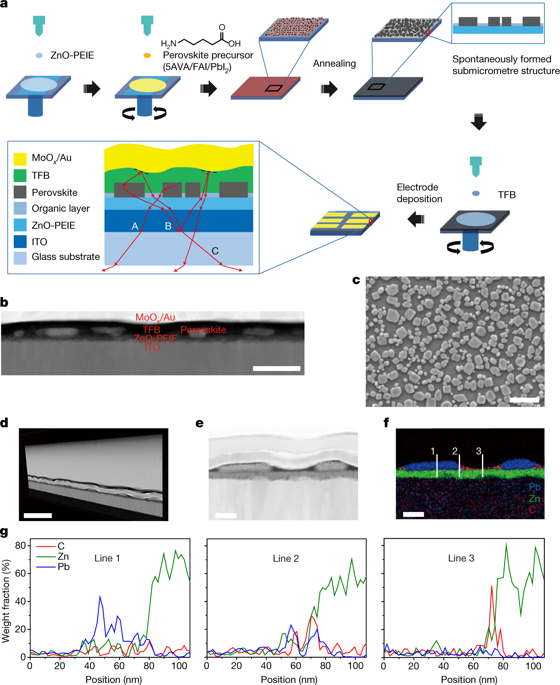Our official English website, www.x-mol.net, welcomes your
feedback! (Note: you will need to create a separate account there.)
Perovskite light-emitting diodes based on spontaneously formed submicrometre-scale structures
Nature ( IF 50.5 ) Pub Date : 2018-10-01 , DOI: 10.1038/s41586-018-0576-2 Yu Cao , Nana Wang , He Tian , Jingshu Guo , Yingqiang Wei , Hong Chen , Yanfeng Miao , Wei Zou , Kang Pan , Yarong He , Hui Cao , You Ke , Mengmeng Xu , Ying Wang , Ming Yang , Kai Du , Zewu Fu , Decheng Kong , Daoxin Dai , Yizheng Jin , Gongqiang Li , Hai Li , Qiming Peng , Jianpu Wang , Wei Huang
Nature ( IF 50.5 ) Pub Date : 2018-10-01 , DOI: 10.1038/s41586-018-0576-2 Yu Cao , Nana Wang , He Tian , Jingshu Guo , Yingqiang Wei , Hong Chen , Yanfeng Miao , Wei Zou , Kang Pan , Yarong He , Hui Cao , You Ke , Mengmeng Xu , Ying Wang , Ming Yang , Kai Du , Zewu Fu , Decheng Kong , Daoxin Dai , Yizheng Jin , Gongqiang Li , Hai Li , Qiming Peng , Jianpu Wang , Wei Huang

|
Light-emitting diodes (LEDs), which convert electricity to light, are widely used in modern society—for example, in lighting, flat-panel displays, medical devices and many other situations. Generally, the efficiency of LEDs is limited by nonradiative recombination (whereby charge carriers recombine without releasing photons) and light trapping1–3. In planar LEDs, such as organic LEDs, around 70 to 80 per cent of the light generated from the emitters is trapped in the device4,5, leaving considerable opportunity for improvements in efficiency. Many methods, including the use of diffraction gratings, low-index grids and buckling patterns, have been used to extract the light trapped in LEDs6–9. However, these methods usually involve complicated fabrication processes and can distort the light-output spectrum and directionality6,7. Here we demonstrate efficient and high-brightness electroluminescence from solution-processed perovskites that spontaneously form submicrometre-scale structures, which can efficiently extract light from the device and retain wavelength- and viewing-angle-independent electroluminescence. These perovskites are formed simply by introducing amino-acid additives into the perovskite precursor solutions. Moreover, the additives can effectively passivate perovskite surface defects and reduce nonradiative recombination. Perovskite LEDs with a peak external quantum efficiency of 20.7 per cent (at a current density of 18 milliamperes per square centimetre) and an energy-conversion efficiency of 12 per cent (at a high current density of 100 milliamperes per square centimetre) can be achieved—values that approach those of the best-performing organic LEDs.The formation of submicrometre-scale structure in perovskite light-emitting diodes can raise their external quantum efficiency beyond 20%, suggesting the possibility of both high efficiency and high brightness.
中文翻译:

基于自发形成亚微米级结构的钙钛矿发光二极管
将电转换为光的发光二极管 (LED) 在现代社会中得到了广泛的应用——例如,在照明、平板显示器、医疗设备和许多其他情况下。通常,LED 的效率受到非辐射复合(即电荷载流子复合而不释放光子)和光捕获 1-3 的限制。在有机 LED 等平面 LED 中,大约 70% 至 80% 的发射器产生的光被困在器件中 4,5,这为提高效率留下了相当大的机会。许多方法,包括使用衍射光栅、低折射率网格和屈曲图案,已被用于提取 LED6-9 中捕获的光。然而,这些方法通常涉及复杂的制造过程,并且会扭曲光输出光谱和方向性 6,7。在这里,我们展示了溶液处理钙钛矿的高效和高亮度电致发光,这些钙钛矿自发形成亚微米级结构,可以有效地从器件中提取光并保留与波长和视角无关的电致发光。这些钙钛矿是通过将氨基酸添加剂引入钙钛矿前体溶液中而形成的。此外,添加剂可以有效钝化钙钛矿表面缺陷并减少非辐射复合。钙钛矿 LED 的峰值外量子效率为 20.7%(在每平方厘米 18 毫安的电流密度下)和 12% 的能量转换效率(在每平方厘米 100 毫安的高电流密度下) — 接近性能最佳有机 LED 的值。
更新日期:2018-10-01
中文翻译:

基于自发形成亚微米级结构的钙钛矿发光二极管
将电转换为光的发光二极管 (LED) 在现代社会中得到了广泛的应用——例如,在照明、平板显示器、医疗设备和许多其他情况下。通常,LED 的效率受到非辐射复合(即电荷载流子复合而不释放光子)和光捕获 1-3 的限制。在有机 LED 等平面 LED 中,大约 70% 至 80% 的发射器产生的光被困在器件中 4,5,这为提高效率留下了相当大的机会。许多方法,包括使用衍射光栅、低折射率网格和屈曲图案,已被用于提取 LED6-9 中捕获的光。然而,这些方法通常涉及复杂的制造过程,并且会扭曲光输出光谱和方向性 6,7。在这里,我们展示了溶液处理钙钛矿的高效和高亮度电致发光,这些钙钛矿自发形成亚微米级结构,可以有效地从器件中提取光并保留与波长和视角无关的电致发光。这些钙钛矿是通过将氨基酸添加剂引入钙钛矿前体溶液中而形成的。此外,添加剂可以有效钝化钙钛矿表面缺陷并减少非辐射复合。钙钛矿 LED 的峰值外量子效率为 20.7%(在每平方厘米 18 毫安的电流密度下)和 12% 的能量转换效率(在每平方厘米 100 毫安的高电流密度下) — 接近性能最佳有机 LED 的值。











































 京公网安备 11010802027423号
京公网安备 11010802027423号